Kushiro manhole cover. These are so convenient; you have yourself an instant logo for every place you visit here in Japan.
Kushiro is a city and airport on the south-west coast of Hokkaido. It's not a tourist destination, really; it seems to mostly live by fishing and other industry in the area. There's large wetlands to the north, a crane reservation towards the airport and wildlife preserves in the area. It seems to attract a fair number of hikers, birdwatchers and fishermen, most of whom of course really just pass through the city itself.
Now, the bad thing about Kushiro is, it feels like a sleepy town of, oh, 30-40 thousand people. It's bad because the population is actually over 180.000 people, but the city center is in bad shape. There are few people around and it seems every third building is shuttered or empty along the major streets. And not just shops either, but hotels and entire office buildings stand abandoned. Cheap business hotels are doing well though; many bankers, lawyers and real estate people travel here for bankrupcy and foreclosure proceedings.
Side street in the city center, just on the corner to the north-south main street from the station. Moody and photogenic, true, but I can't honestly say it makes me want to settle down in the area.
An eloge to Ritsuko, who did her level best to stand still for the four-second exposure.
Without businesses to fill all those buildings there's a lack of jobs to be had. And without work, the young people leave for Sapporo in the east - or for Tokyo-Nagoya-Osaka, away from Hokkaido altogether. And once people leave they're not likely to come back. The recession is accelerating things of course, but Kushiro and other places like it has been losing people for years; major metropolitan hubs the world over are growing at the expense of smaller regional communities.
And in the case of Kushiro, some of the blame also falls on the city itself. According to locals, there's several new malls open in the suburbs, malls that are doing OK, but sucking the life out of the city center. That in turn hurts tourism and discourages people from moving here - who wants to live in a gloomy ghost town after all, if you can avoid it? Approving the construction of large malls on the periphery may make financial sense in the short term, but hurts the city badly over time. And the loss of tax revenue from the center and the cost of "revitalization efforts" probably eats most of the tax revenue from those malls anyway.
The city is quite pleasant to walk around in, and it feels there should be more people and more activity than there is. Here's a koban - a neighbourhood police station - right next to a park.
The good things about Kushiro, on the other hand, are very good. Delicious in fact. It is, of course, the food. We had dinner, breakfast buffé and lunch, in that order, and were not served a single molecule that was anything less than delicious.
Fish on sale along the main street. If you like fish, Hokkaido is the place to go. Better, fresher and cheaper than anywhere else in the country.
The breakfast buffé at the chain hotel (Tokyo Inn) had several varieties of fish including salmon and whole shishamo; miso soup, okayu, natto and rice; breads, sausage, ham, potatoes and scrambled eggs; tofu, onsen tamago and udon; salads, fruit and yoghurt; milk, juices, tea (Japanese and English) and coffee (regular and espresso). It was far beyond any I've had at a business hotel before in both variety and quality, and better than most breakfasts I've had at much higher class hotels.
Lunch was Kushiro-style ramen - thin noodles in a soy-based soup. And while it was light it was still savoury and warming - perfect after a few hours of walking along the waterfront.
The high point was "Aburiya", a Robata-style restaurant, where the food - fish and meat - is cooked on large charcoal griddles in the middle of the room. Here, again, every single thing we ordered was great. We weren't the only ones to think so either; the restaurant was packed with locals, and we only just managed to get two seats along the counter. Which, by the way, is much more fun than getting a table, as you can see the cooks work the hot griddles. We had hokke, hoya, ramen salad, steak, "Inka potatoes" (yellow and very flavourful, served with butter), onigiri, ochazuke and clam miso soup.
Kushiro is known for its robata restaurants. Aburiya is recommended by a fair number of people, and for good reason.
Hokke is a kind of mackerel native to the Hokkaido area. It's often served like this: opened, dried, then grilled and eaten like this. The savoury, firm meat is delicious as is; lemon or soy sauce would only dilute the taste. The plate in the background is a ramen salad.
Hoya is sea squirt, a relative of the sea anemone, for instance. It's swims freely as a juvenile, but as an adult it settles onto a rock and makes a living by siphoning the water for algae. At Aburiya you lightly grill it yourself at the table, and eat with a drop of lemon. I really liked hoya - it's similar in flavour and texture to grilled oysters - but Ritsuko didn't really take to it.
The waterfront is another asset of the city. It's pretty cool, with a mix of working boats and some tourist-oriented stuff. Fishing boats lie right along the river towards the sea, and the heavy barges, coast guard vessels and other "real" working stuff is easy to get to and see up close.
There's a shopping market and community center of sorts - MOO - right on the river edge that is surprisingly good, with lots of local products, eateries, exhibition areas, a Hello Work office, an arboretum (very pleasant in the winter) and so on. It wasn't exactly bustling, but it wasn't empty either. We got a bottle of the local sake, and some really tasty cheese-senbei. There is - or was, I'm not sure - a local brewery nearby with pub and tours as well, but it was closed when we got there. The week around christmas is low season for travel here (the New Years holiday starts one week later), so our impression of things may well be more downbeat than normal.
There's more pictures of Kushiro in my Kushiro set on flickr, for anyone interested.
There's a shopping market and community center of sorts - MOO - right on the river edge that is surprisingly good, with lots of local products, eateries, exhibition areas, a Hello Work office, an arboretum (very pleasant in the winter) and so on. It wasn't exactly bustling, but it wasn't empty either. We got a bottle of the local sake, and some really tasty cheese-senbei. There is - or was, I'm not sure - a local brewery nearby with pub and tours as well, but it was closed when we got there. The week around christmas is low season for travel here (the New Years holiday starts one week later), so our impression of things may well be more downbeat than normal.
There's more pictures of Kushiro in my Kushiro set on flickr, for anyone interested.
The waterfront is right in the city center, south of the station. Working boats lie right along the city streets and bridges.
Squid fishing boats use rows of bright lamp lights to attact squid at night. This, by the way, caused some issues when oil prices spiked a couple of years ago; the generators they use to power the lights consume a fair amount of diesel. Squid fishermen demanded (and, I think, got) a subsidy for the lamp diesel. I can't help thinking there has to be a less wasteful way of doing it.

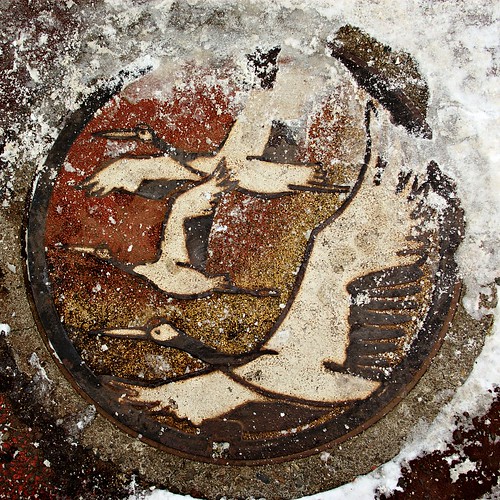
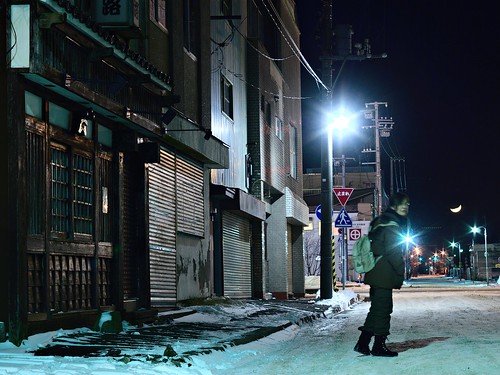
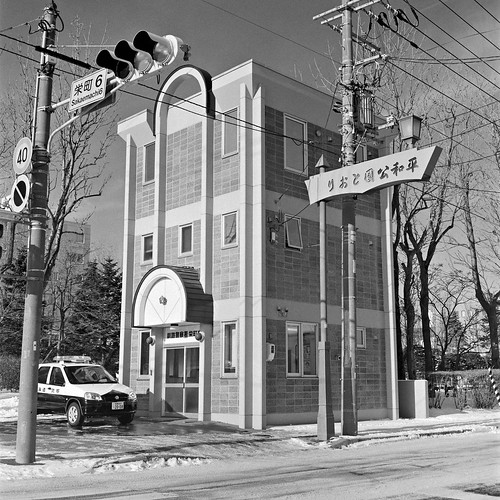
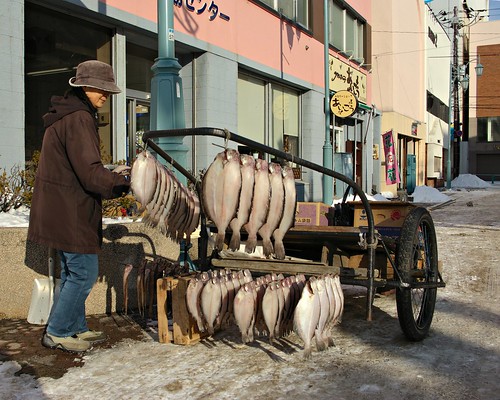
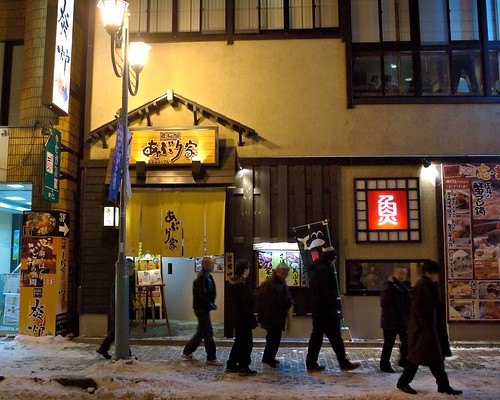
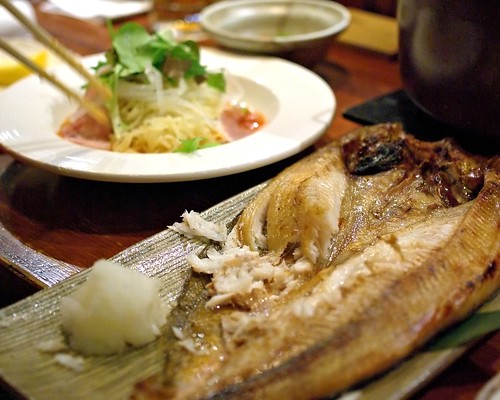

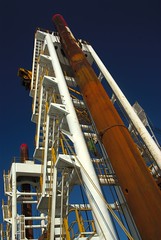
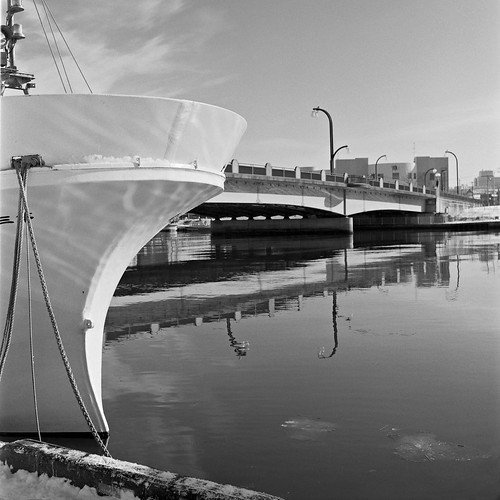
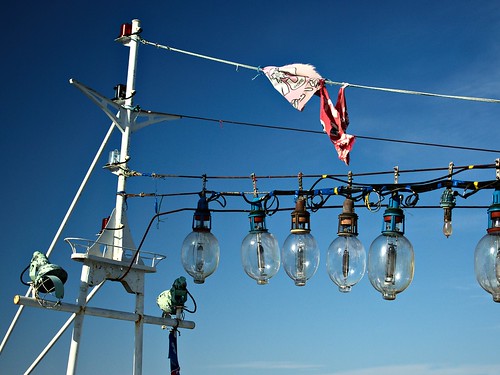

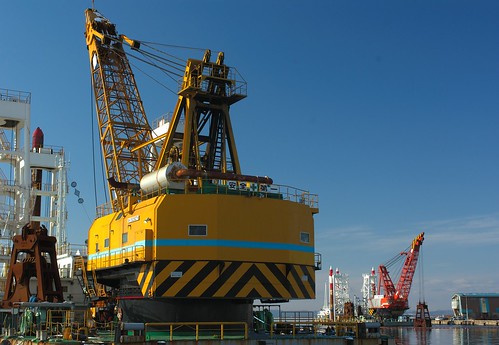
Beautiful shots - the colors of the manhole cover together with the ice makes this one really great! The hokke looks so delicious - almost makes me want to go to Hokkaido now :)
ReplyDeleteAnd no, it's of course not just you - big machines ARE cool.
Jonas, Tokyo
my husband and i are planning to go to Kushiro in this November not much expectation from this sleepy town and Kushiro reminds me of the City of Winnipeg in Central Canada. We will stopover for 1 night or two before heading to the Lakes.
ReplyDelete